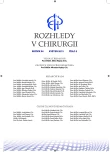Femoropopliteal deep vein thrombosis and popliteal artery pseudoaneurysm as a complication of multiple hereditary osteochondromatosis
Authors:
I. Guňka 1; M. Leško 1; P. Janata 1; O. Renc 2
; J. Raupach 2
Authors‘ workplace:
Chirurgická klinika FN a LF UK Hradec Králové, přednosta: prof. MUDr. A. Ferko, CSc.
1; Radiologická klinika FN a LF Hradec Králové, přednosta: prof. MUDr. A. Krajina, CSc.
2
Published in:
Rozhl. Chir., 2015, roč. 94, č. 5, s. 207-210.
Category:
Case Report
Overview
Osteochondromas (exostoses) are the most common benign bone tumours. In most cases, osteochondroma occurs as a solitary lesion. Hereditary multiple osteochondromatosis is an autosomal dominant disorder manifested by multiple exostoses most commonly located at the metaphyses of long bones, the iliac crest, the ribs, the vertebral borders, and scapulas. Vascular complications of multiple osteochondromatosis are very rare, most frequently affecting the popliteal artery. The authors report the case of a 27-year-old female patient with hereditary multiple osteochondromatosis that was complicated by femoropopliteal deep vein thrombosis and giant popliteal artery pseudoaneurysm.
Key words:
multiple osteochondromatosis − popliteal artery − pseudoaneurysm − deep vein thrombosis
Sources
1. Vasseur MA, Fabre O. Vascular complications of osteochondromas. J Vasc Surg 2000;31 : 532−8.
2. Stieber JR, Pierz KA, Dormans JP. Hereditary multiple exostoses: A current understanding of clinical and genetis advances. The University of Pennsylvania Orthopaedic Journal. 2001;14 : 39−48.
3. Fletcher CDM. WHO Classification of Tumours of Soft Tissue and Bone, 4th Edition. Lyon, International Agency for Research on Cancer 2013.
4. Wicklund CL, Pauli RM, Johnston D, et al. Natural history study of hereditary multiple exostoses. Am J Med Genet 1995;55 : 43−6.
5. Barros Filho TE, Oliveira RP, Taricco MA, et al. Hereditary multiple exostoses and cervical ventral protuberance causing dysphagia. A case report. Spine 1995;20 : 1640−2.
6. Castells L, Comas P, González A, et al. Case report: haemothorax in hereditary multiple exostosis. Br J Radiol 1993;66 : 269−70.
7. Dungl P, a kol. Ortopedie, 2. přepracované a doplněné vydání. Praha, Grada 2014.
8. Andrikopoulos V, Skourtis G, Papacharalambous G, et al. Arterial compromise caused by lower limb osteochondroma. Vasc Endovascular Surg 2003;37 : 185−90.
9. Al-Hadidy AM, Al-Smady MM, Haroun AA, et al. Hereditary multiple exostoses with pseudoaneurysm. Cardiovasc Intervent Radiol 2007;30 : 537−40.
10. Perez-Burkhardt JL, Gómez Castilla JC. Postraumatic popliteal pseudoaneurysm from femoral osteochondroma: case report and review of the literature. J Vasc Surg 2003;37 : 669−71.
11. Proček J, Tomšů M, Roček V. Cévní komplikace u osteochondromatózy. Acta Chir Orthop Traumatol Cech 1985;52 : 85−7.
12. Matsushita M, Nishikimi N, Sakurai T, et al. Pseudoaneurysm of the popliteal artery caused by exostosis of the femur: case report and review of the literature. J Vasc Surg 2000;32 : 201−4.
13. Christensen JD, Monu JU. Multimodality imaging in the diagnosis of deep vein thrombosis and popliteal pseudoaneurysm complicating a sessile osteochondroma. Pediatr Radiol 2008;38 : 887−91.
Labels
Surgery Orthopaedics Trauma surgeryArticle was published in
Perspectives in Surgery

2015 Issue 5
- Metamizole vs. Tramadol in Postoperative Analgesia
- Metamizole at a Glance and in Practice – Effective Non-Opioid Analgesic for All Ages
- Metamizole in perioperative treatment in children under 14 years – results of a questionnaire survey from practice
Most read in this issue
- Pancreatic metastases − diagnosis, radical surgery, complications and survival
- Endometriosis of the appendix presenting like acute appendicitis – a case report
- Intestinal volvulus caused by the ingestion of magnet balls: unexpected risk in children
- Femoropopliteal deep vein thrombosis and popliteal artery pseudoaneurysm as a complication of multiple hereditary osteochondromatosis
